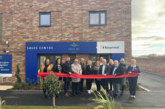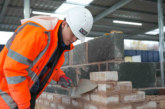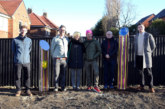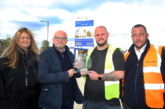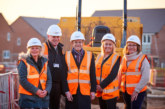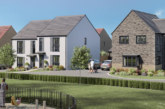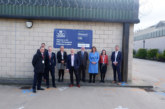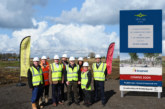Thanks to a £260m regeneration project in Anfield, Liverpool, more than 600 new homes have been built in the area and 600 existing properties refurbished. Claire Clutten speaks to Dave Litherland at Your Housing Group and Ben Ormsby at Keepmoat about the ambitious programme, which is helping deliver a brighter future for Anfield.
Above: Mark Tattersall, former chair at Your Housing Group with Rockfield Road in Anfield resident Nikki Leech.
Anfield is home to one of the top football clubs in the UK and is currently undergoing a revival thanks to a massive investment programme. The area has witnessed a significant amount of change over the last two decades. The Anfield Regeneration Project — a pioneering partnership between Liverpool City Council, Your Housing Group, Liverpool Football Club and Keepmoat Homes — is breathing new life into the area, which extends much deeper than bricks and mortar improvements.
In big cities, urban areas can fall into decline for various reasons. Anfield is densely populated with pre 1919 terraced homes. By the late 1990s early 2000s, terraced back of pavement houses, prevalent in many northern cities and towns, began to wane in popularity. In Anfield, many of these properties had fallen into serious disrepair, with a number vacant and boarded up. The street scenes were far from idyllic. Local residents cited a number of other issues too, including a lack of parking, amenity space and children’s play areas, as well as poor shopping facilities, and the additional pressures that only surfaced on match days.
In 1999, Liverpool Football Club sought to expand its stadium. The City Council and the then Liver Housing Association worked together on potential urban renewal plans, which could facilitate a stadium expansion, and carried out a community consultation exercise to garner feedback from residents. There was a huge outcry amongst locals to the plans, as people felt as though they were ‘having the work done to them, not with them’ and as a consequence, the proposals foundered. Such was the strength of public feeling in the area at the time that a number of residents’ groups mobilised and a community plan was mooted, which took several years to develop.

Housing Market Renewal
Fast-forward four years to 2003, when government announced the Housing Market Renewal (HMRI) programme and funding was made available to facilitate a 15-year regeneration project in Anfield, based around the community plan. Dave Litherland, Head of Anfield for Your Housing Group, says: “With the constraints on money now, would you start a programme that lasts 15 years that relies on government money? That’s what we did and Anfield was the only 15-year programme, all the rest were 10, as far as I’m aware. It was a big renewal area, covering about 5,000 properties.”
In the original plans, the proposals were to knock down approximately 200 homes around the stadium to facilitate its expansion. The community plan identified somewhere in the region of 1,400 properties to be demolished and these were all away from the stadium.
Dave continues: “The result of the community plan was that when the Housing Market Renewal came, there was a mechanism to fund that programme and what people in the area were saying they would like, such as more modern homes, gardens, more space, better housing facilities and so on. Residents were very unhappy with the proposal in 1999, then the Housing Market Renewal programme came in and was delivering what residents wanted, albeit slowly. The HMRI programme was running fairly successfully until the credit crunch started around 2006.”
Unfortunately, in 2008, with the recession biting hard, HMRI funding was withdrawn and the project ground to a halt. Dave says: “There were houses that had been cleared, land that was ready for Keepmoat to develop and the whole area was uncertain.”
When government was no longer able to fund the programme, it was a significant blow to the local community, especially given the amount of disruption caused, which residents endured on the understanding they were going to see the improvements they were calling for, come to fruition. The local community were left in limbo. Dave says: “Some of the areas had been identified for demolition in the later phases, a lot of people had already moved out, so there were a lot of vacant properties. When we came to 2013 we had a very unhappy neighbourhood.”
Many people in the local community felt they had been abandoned, and not just by local government and partners, but by central government too. Dave says: “There was quite a bit of lobbying to central government by residents saying ‘you can’t just leave us this way’.”

Ringing the changes
In 2012 Your Housing Group was created following the merger of Harvest Housing Association and Arena Housing Group, with Brian Cronin as Group Chief Executive. The following year, Liverpool Football Club changed hands and Liverpool City Council appointed a new Mayor, Joe Anderson, who identified Anfield as a priority area. Dave says: “The three organisations got together and said why can’t we work together, we all want Anfield to be a better place. The football club said, if you can get some certainty on the housing, we want to work with you on the plan to improve the area.
“In 2013 the new partnership carried out an extensive consultation on how the partners could help deliver an improved park and stadium, some commercial spaces and a new high street on Walton Breck Road, continue the new housing through Keepmoat Homes, who were appointed as lead developer through Liverpool City Council, and create a better connected area of terraced houses. Some of the terraces had been identified for demolition. Some were showing real signs of physical decline because of the uncertainty of the football club. All the partners had a job to do.”
Revitalising the Anfield Village and Rockfield areas to provide ‘safe, secure, sustainable residential neighbourhoods, conducive to community life’ was the genesis of the Anfield Regeneration Project. The four partners agreed roles and responsibilities and spoke candidly to the community, admitting they’d got it wrong, apologising to residents for all the turmoil and uncertainty they had endured. It was essential to rebuild trust within the community for the regeneration project to be a success. Another residents’ consultation took place and 80% of those consulted said they were happy with the new plan the partners had devised. A commitment was made to resolve the key issues and each organisation within the partnership put up substantial resources towards turning the area around.
Dave says: “To link it all together as a partnership we created a Spatial Generation Framework and what this did is, it gave clears remits as to where housing would be built and maintained, where commercial space could be developed, it gave the blueprint for the park to be improved, so it just made it very clear and that is just used in a planning form for future developments.”
Investing in the area
The £260m programme, which is ongoing, includes £72m of new housing, the demolition of derelict properties, the restoration of neighbouring Stanley Park, as well as the construction of Four Oaks Primary School and Mere Lane Health Centre. Your Housing Group has invested more than £23m into developing 161 new homes for private rent and shared ownership and regenerating 27 homes for affordable rent.
Dave says: “We got to work very quickly on two show homes to show how the older properties could look once refurbished. We knocked a couple of ‘two up and two down’ properties in together to create a large three-bedroom house with more space and a garden, allowing residents to see how they could live there, which was really well received. We started to improve some of the worst properties in and around the football club area, so all of a sudden, people could see something good was happening and that gave them confidence.
“We had worked with Liverpool City Council and the Housing Corporation to allow property and land owned by Your Housing Group to be transferred to Keepmoat Homes to allow much needed new homes to be developed.”
The housing association had previously bought properties from homeowners in Tancred Road in the Rockfield area to avoid speculators coming in, which back in 1999 were largely empty, due to civil unrest. Your Housing Group worked with a private developer to improve the properties for sale. These properties were sold at a peak in 2005/6 for £150,000 only for the credit crunch to hit leaving homeowners in negative equity. People who bought the properties paid a high price — considerably more than the homes are worth now — and as a consequence felt trapped.
The project failed, the developer defaulted and the housing association bought back the properties — an expensive hit. Your Housing Group has since completely regenerated Tancred Road and it now looks lovely — the street scene barely recognisable from what it was over 10 years ago. All the properties have either been re-let through shared ownership or sold.
Dave says: “We have spent nearly £200,000 on renovating some of the properties because of the poor condition and to keep the street scene, we’ve not done it on all, that’s the worst case scenario. Some would question, why are you investing so much? This is a real issue that down in London is difficult for people to understand.”
Why spend more money ‘doing a property up’ than it is worth? Dave says: “The issue we had, we couldn’t just leave a hole in the street, we had to do it. There were end terraces that needed to be rebuilt and they cost. It is a difficult decision to make for a business, but we’re looking at the wider picture here, to leave the properties in that condition simply wasn’t acceptable.”
High stakes
For Your Housing Group and partners on this project, the stakes are high. It’s not just about providing modern homes and regenerating existing homes, it’s about improving outcomes and life chances for people, providing opportunities. In Liverpool the average mortality rates for males is 71, 76 for females, below average for England. Dave says: “You’re going to live less if you were born and live here, some of that is because of the health provision, some of it is because of the housing, so that’s why it’s important for us to renovate and maintain these areas.”
Ben Ormsby at Keepmoat Homes picks up the story: ”We’ve been involved in the regeneration of Anfield since 2004, when we began working with Liverpool City Council on the Stanley Park zone, then over that course of time became involved in the Anfield regeneration project as it is now.”
Andy Denton, Head of Land and Partnerships at Keepmoat Homes, comments: “Our role in the partnership has been focused on delivering much needed new housing to the area. To date we have completed over 500 homes for both affordable tenures in partnership with Your Housing Group and also for private sale, increasing home ownership in the area. Phase four of our development is nearly complete and the final fifth phase, a further 86 new two-, three- and four-bedroom homes, is underway.
Ben says: “As well as that we’ve been working with the community on a number of projects. There’s an organisation called Home Baked, a community land trust and co-operative bakery near the stadium. The land trust aims to help young and local people get into work, offering various training courses. We’ve helped support a number of different courses, including health and safety and fire warden courses through them, for local people. We’ve also done a lot of work with local schools on health and safety and to educate children on the career opportunities in the construction sector. We always try and get local apprentices on site on all projects we do.”
Andy adds: “As part of our commitment to support the local community during this project, we’re proud to have engaged local schools and supported with the Homebaked traineeship and offered Rotunda College staff training in areas including health and safety.”
Community minded
Homebaked says it is ‘proposing to regenerate our high street brick by brick and loaf by loaf’. The community land trust saved the local neighbourhood bakery, which straddles the border between Anfield and Everton and now it’s thriving, supplying the famous ‘Scouse’ pie to the football club on match days. The CLT trains and employs local people on a living wage at the bakery and uses only local producers and suppliers. Any profits made are reinvested in the local community. The Homebaked concept embodies the community land trust spirit, reflected by the Anfield Regeneration Project, which is about creating opportunities for local people and a place people are proud to live, work and support.
The Anfield regeneration partnership is not just investing in homes but investing in people, striving to create a vibrant sustainable Anfield with a brighter future, which, like the football club, seems to be on an upward trajectory. The partners may have made mistakes along the way, but they’ve been honest about them and despite government funding being withdrawn at a crucial part of the process, they’ve persevered. The local community has faced many hardships along the way, but now, finally, they are seeing the positive face of regeneration. The brickwork on the properties has been restored to its former glory, the wide streets have been landscaped and Anfield is an area definitely on the ‘up’.
A book produced by project architects and designers, Halsall Lloyd Partnership, details the vision behind the regeneration masterplan, the key objectives, challenges and opportunities. Seeing the photos of the area before work commenced and walking round Anfield now, the difference is incredible. The football club has an expanded stadium, a new fan zone and merchandise shop. The beautiful Victorian properties have been restored. There are now new shopping facilities and amenities, plus plans to build a new hotel and business centre in the pipeline as part of the final phase of works. The 111-acre Stanley Park boasts the Isla Conservatory, a pretty Grade II listed Victorian conservatory used as a venue for community events and weddings, which now also hosts career fairs to make local people aware of the training and employment opportunities available.
Wayne Hemingway of Hemingway Design has worked with Your Housing Group to develop a new marketing brand — ‘Anfield is’ — to entice people back to the area. In HLP’s guide it talks about ‘bringing you a brighter future’. That certainly seems to be true for Anfield.


